Abstract
This study was designed to assess the effects of morphine sulfate on glucose kinetics and on glucoregulatory hormones in conscious overnight fasted dogs. One group of experiments established a dose-response range. We studied the mechanisms of morphine-induced hyperglycemia in a second group. We also examined the effect of low dose morphine on glucose kinetics independent of changes in the endocrine pancreas by the use of somatostatin plus intraportal replacement of basal insulin and glucagon. In the dose-response group, morphine at 2 mg/h did not change plasma glucose, while morphine at 8 and 16 mg/h caused a hyperglycemic response. In the second group of experiments, morphine (16 mg/h) caused an increase in plasma glucose from a basal 99 +/- 3 to 154 +/- 13 mg/dl (P less than 0.05). Glucose production peaked at 3.9 +/- 0.7 vs. 2.5 +/- 0.2 mg/kg per min basally, while glucose clearance declined to 1.7 +/- 0.2 from 2.5 +/- 0.1 ml/kg per min (both P less than 0.05). Morphine increased epinephrine (1400 +/- 300 vs. 62 +/- 8 pg/ml), norepinephrine (335 +/- 66 vs. 113 +/- 10 pg/ml), glucagon (242 +/- 53 vs. 74 +/- 14 pg/ml), insulin (30 +/- 9 vs. 10 +/- 2 microU/ml), cortisol (11.1 +/- 3.3 vs. 0.9 +/- 0.2 micrograms/dl), and plasma beta-endorphin (88 +/- 27 vs. 23 +/- 6 pg/ml); all values P less than 0.05 compared with basal. These results show that morphine-induced hyperglycemia results from both stimulation of glucose production as well as inhibition of glucose clearance. These changes can be explained by rises in epinephrine, glucagon, and cortisol. These in turn are part of a widespread catabolic response initiated by high dose morphine that involves activation of the sympathetic nervous system, the endocrine pancreas, and the pituitary-adrenal axis. Also, we report the effect of a 2 mg/h infusion of morphine on glucose kinetics when the endocrine pancreas is clamped at basal levels. Under these conditions, morphine exerts a hypoglycemic effect (25% fall in plasma glucose, P less than 0.05) that is due to inhibition of glucose production (by 25-43%, P less than 0.05). The hypoglycemia was independent of detectable changes in insulin, glucagon, epinephrine and cortisol, and was not reversed by concurrent infusion of a slight molar excess of naloxone. Therefore, we postulate that the hypoglycemic effect of morphine results from the interaction of the opiate with non-mu receptors either in the liver or the central nervous system.
Full text
PDF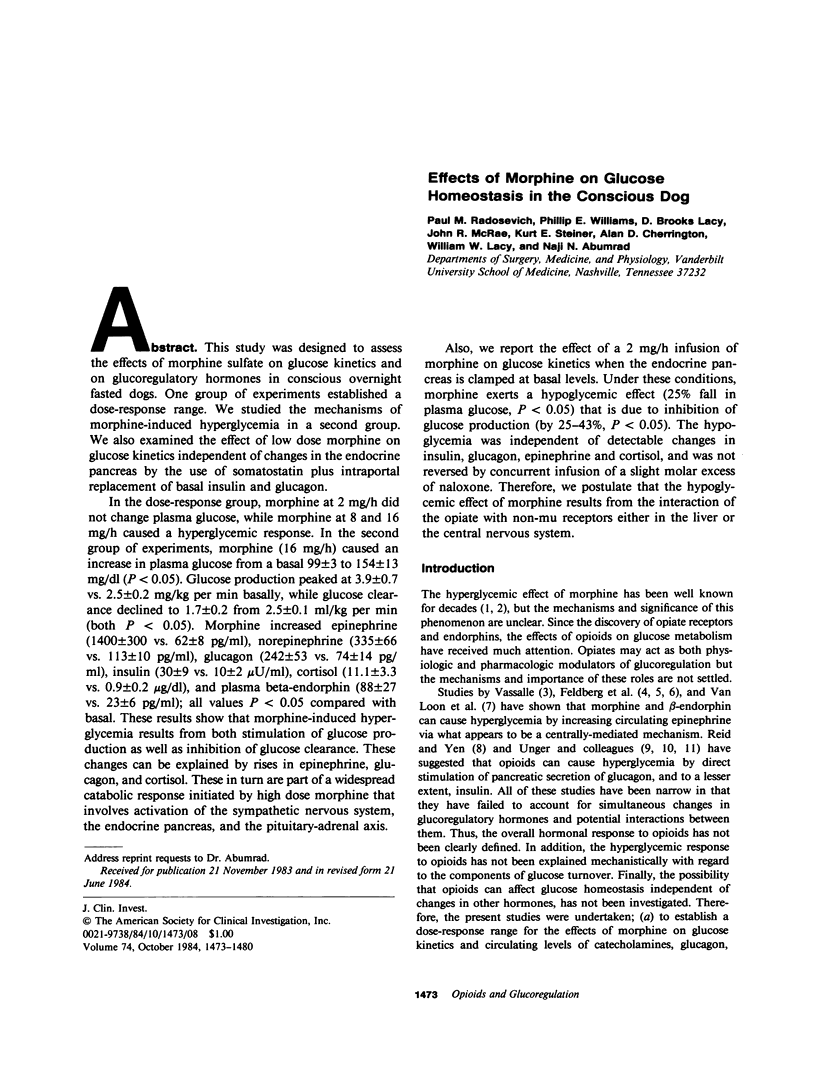
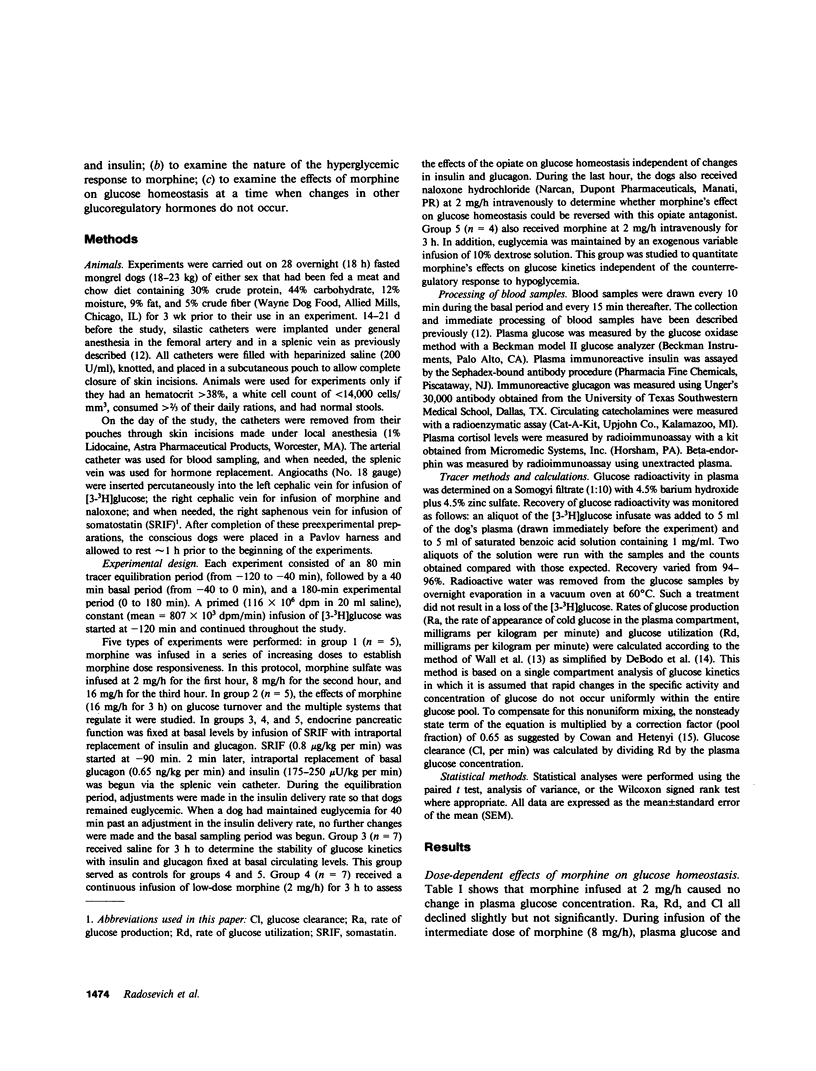
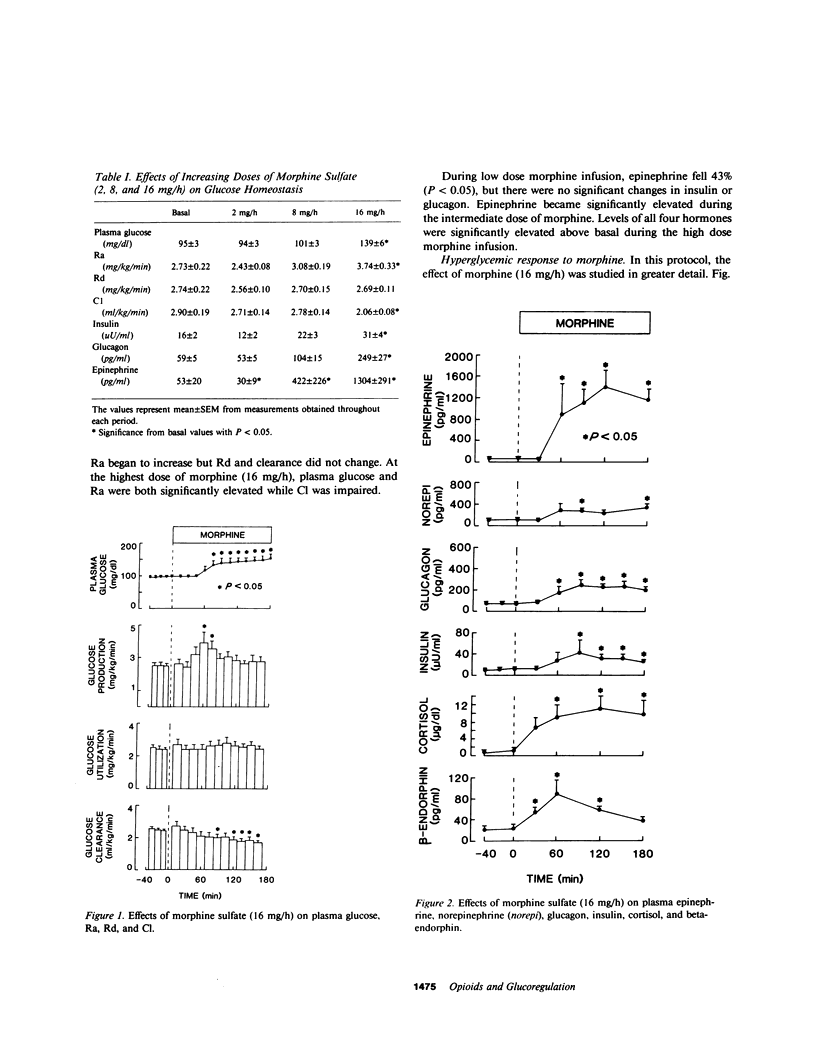
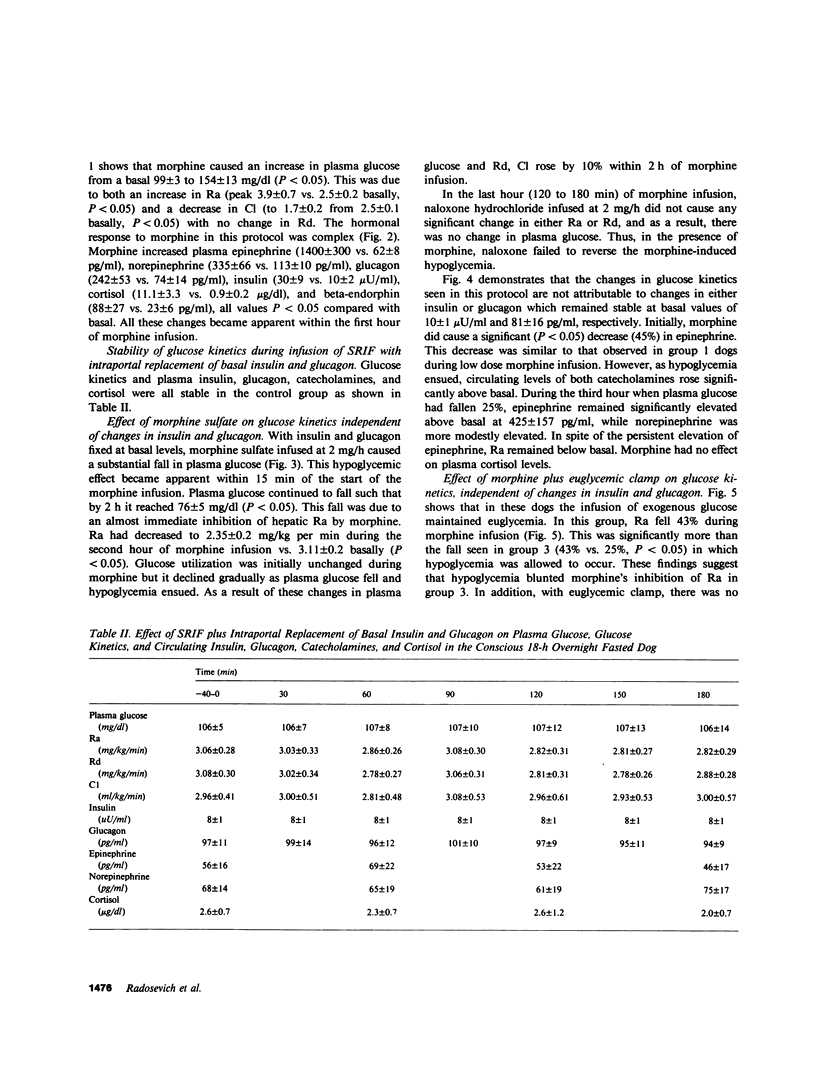
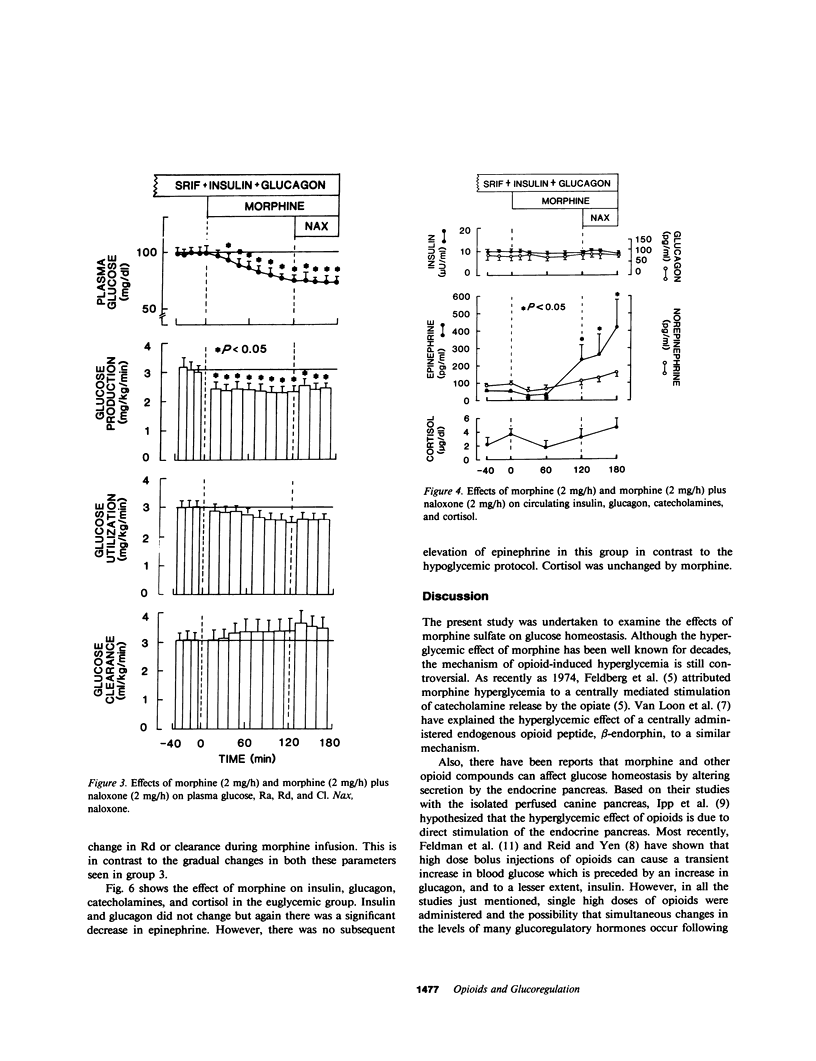
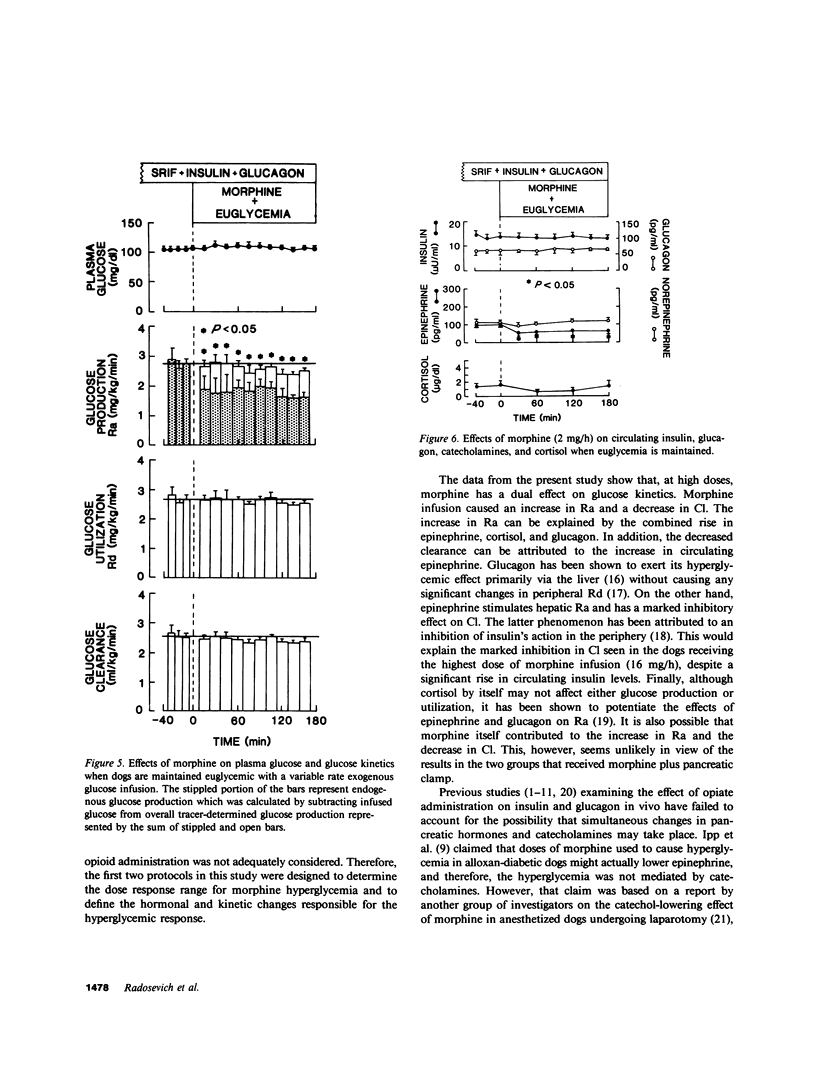
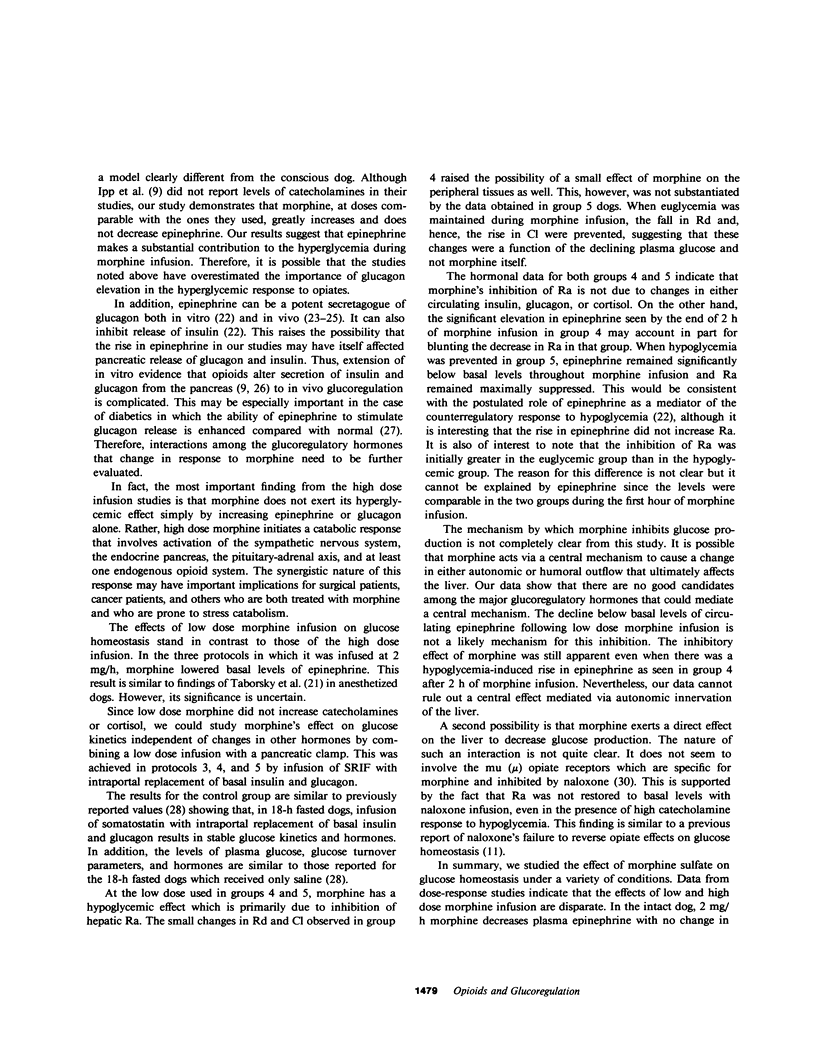
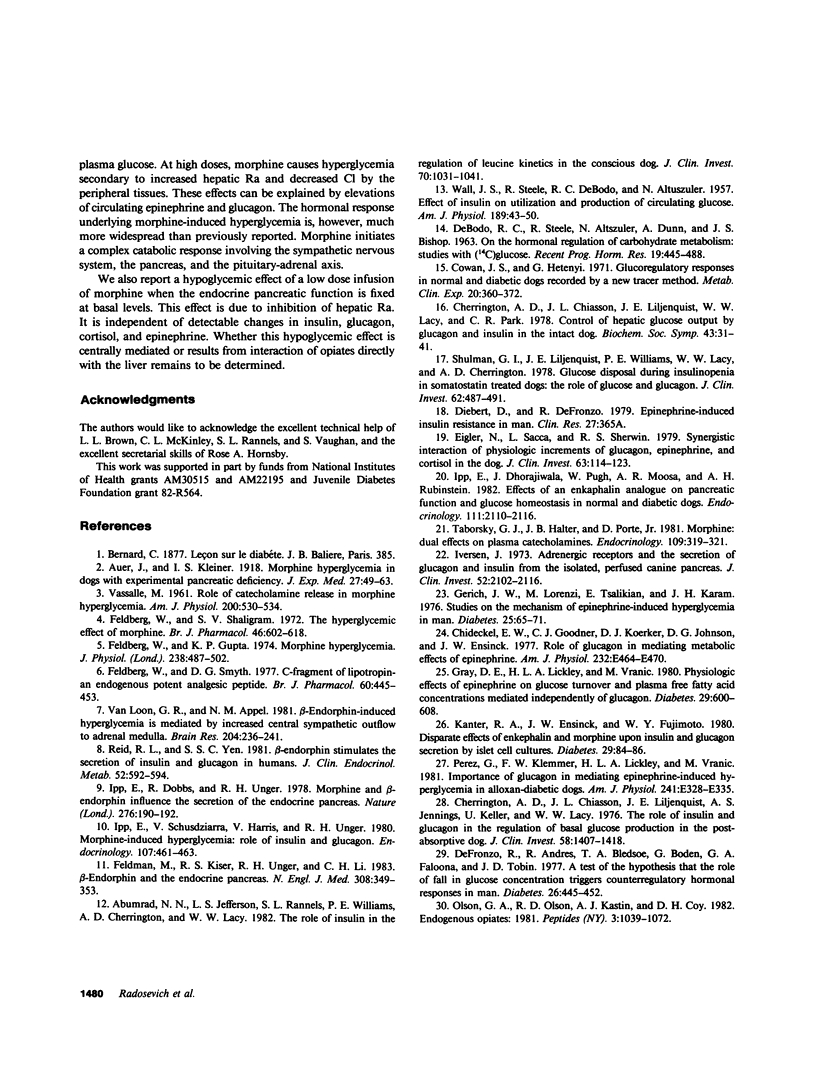
Selected References
These references are in PubMed. This may not be the complete list of references from this article.
- Abumrad N. N., Jefferson L. S., Rannels S. R., Williams P. E., Cherrington A. D., Lacy W. W. Role of insulin in the regulation of leucine kinetics in the conscious dog. J Clin Invest. 1982 Nov;70(5):1031–1041. doi: 10.1172/JCI110690. [DOI] [PMC free article] [PubMed] [Google Scholar]
- Cherrington A. D., Chiasson J. L., Liljenquist J. E., Jennings A. S., Keller U., Lacy W. W. The role of insulin and glucagon in the regulation of basal glucose production in the postabsorptive dog. J Clin Invest. 1976 Dec;58(6):1407–1418. doi: 10.1172/JCI108596. [DOI] [PMC free article] [PubMed] [Google Scholar]
- Cherrington A. D., Chiasson J. L., Liljenquist J. E., Lacy W. W., Park C. R. Control of hepatic glucose output by glucagon and insulin in the intact dog. Biochem Soc Symp. 1978;(43):31–45. [PubMed] [Google Scholar]
- Chideckel E. W., Goodner C. J., Koerker D. J., Johnson D. G., Ensinck J. W. Role of glucagon in mediating metabolic effects of epinephrine. Am J Physiol. 1977 May;232(5):E464–E470. doi: 10.1152/ajpendo.1977.232.5.E464. [DOI] [PubMed] [Google Scholar]
- Cowan J. S., Hetenyi G., Jr Glucoregulatory responses in normal and diabetic dogs recorded by a new tracer method. Metabolism. 1971 Apr;20(4):360–372. doi: 10.1016/0026-0495(71)90098-9. [DOI] [PubMed] [Google Scholar]
- DEBODO R. C., STEELE R., ALTSZULER N., DUNN A., BISHOP J. S. ON THE HORMONAL REGULATION OF CARBOHYDRATE METABOLISM; STUDIES WITH C14 GLUCOSE. Recent Prog Horm Res. 1963;19:445–488. [PubMed] [Google Scholar]
- DeFronzo R. A., Andres R., Bedsoe T. A., Boden G., Faloona G. A., Tobin J. D. A test of the hypothesis that the rate of fall in glucose concentration triggers counterregulatory hormonal responses in man. Diabetes. 1977 May;26(5):445–452. doi: 10.2337/diab.26.5.445. [DOI] [PubMed] [Google Scholar]
- Eigler N., Saccà L., Sherwin R. S. Synergistic interactions of physiologic increments of glucagon, epinephrine, and cortisol in the dog: a model for stress-induced hyperglycemia. J Clin Invest. 1979 Jan;63(1):114–123. doi: 10.1172/JCI109264. [DOI] [PMC free article] [PubMed] [Google Scholar]
- Feldberg W., Gupta K. P. Morphine hyperglycaemia. J Physiol. 1974 May;238(3):487–502. doi: 10.1113/jphysiol.1974.sp010539. [DOI] [PMC free article] [PubMed] [Google Scholar]
- Feldberg W., Shaligram S. V. The hyperglycaemic effect of morphine. Br J Pharmacol. 1972 Dec;46(4):602–618. doi: 10.1111/j.1476-5381.1972.tb06887.x. [DOI] [PMC free article] [PubMed] [Google Scholar]
- Feldberg W., Smyth D. G. C-fragment of lipotropin--an endogenous potent analgesic peptide. Br J Pharmacol. 1977 Jul;60(3):445–453. doi: 10.1111/j.1476-5381.1977.tb07521.x. [DOI] [PMC free article] [PubMed] [Google Scholar]
- Feldman M., Kiser R. S., Unger R. H., Li C. H. Beta-endorphin and the endocrine pancreas. Studies in healthy and diabetic human beings. N Engl J Med. 1983 Feb 17;308(7):349–353. doi: 10.1056/NEJM198302173080701. [DOI] [PubMed] [Google Scholar]
- Gerich J. E., Lorenzi M., Tsalikian E., Karam J. H. Studies on the mechanism of epinephrine-induced hyperglycemia in man. Evidence for participation of pancreatic glucagon secretion. Diabetes. 1976 Jan;25(1):65–71. doi: 10.2337/diab.25.1.65. [DOI] [PubMed] [Google Scholar]
- Gray D. E., Lickley H. L., Vranic M. Physiologic effects of epinephrine on glucose turnover and plasma free fatty acid concentrations mediated independently of glucagon. Diabetes. 1980 Aug;29(8):600–608. doi: 10.2337/diab.29.8.600. [DOI] [PubMed] [Google Scholar]
- Ipp E., Dhorajiwala J., Pugh W., Moossa A. R., Rubenstein A. H. Effects of an enkephalin analog on pancreatic endocrine function and glucose homeostasis in normal and diabetic dogs. Endocrinology. 1982 Dec;111(6):2110–2116. doi: 10.1210/endo-111-6-2110. [DOI] [PubMed] [Google Scholar]
- Ipp E., Dobbs R., Unger R. H. Morphine and beta-endorphin influence the secretion of the endocrine pancreas. Nature. 1978 Nov 9;276(5684):190–191. doi: 10.1038/276190a0. [DOI] [PubMed] [Google Scholar]
- Ipp E., Schusdziarra V., Harris V., Unger R. H. Morphine-induced hyperglycemia: role of insulin and glucagon. Endocrinology. 1980 Aug;107(2):461–463. doi: 10.1210/endo-107-2-461. [DOI] [PubMed] [Google Scholar]
- Iversen J. Adrenergic receptors and the secretion of glucagon and insulin from the isolated, perfused canine pancreas. J Clin Invest. 1973 Sep;52(9):2102–2116. doi: 10.1172/JCI107395. [DOI] [PMC free article] [PubMed] [Google Scholar]
- Kanter R. A., Ensinck J. W., Fujimoto W. Y. Disparate effects of enkephalin and morphine upon insulin and glucagon secretion by islet cell cultures. Diabetes. 1980 Jan;29(1):84–86. doi: 10.2337/diab.29.1.84. [DOI] [PubMed] [Google Scholar]
- Olson G. A., Olson R. D., Kastin A. J., Coy D. H. Endogenous opiates: 1981. Peptides. 1982 Nov-Dec;3(6):1039–1072. doi: 10.1016/0196-9781(82)90075-4. [DOI] [PubMed] [Google Scholar]
- Perez G., Kemmer F. W., Lickley H. L., Vranic M. Importance of glucagon in mediating epinephrine-induced hyperglycemia in alloxan-diabetic dogs. Am J Physiol. 1981 Oct;241(4):E328–E335. doi: 10.1152/ajpendo.1981.241.4.E328. [DOI] [PubMed] [Google Scholar]
- Reid R. L., Yen S. S. beta-Endorphin stimulates the secretion of insulin and glucagon in humans. J Clin Endocrinol Metab. 1981 Mar;52(3):592–594. doi: 10.1210/jcem-52-3-592. [DOI] [PubMed] [Google Scholar]
- Shulman G. I., Liljenquist J. E., Williams P. E., Lacy W. W., Cherrington A. D. Glucose disposal during insulinopenia in somatostatin-treated dogs. The roles of glucose and glucagon. J Clin Invest. 1978 Aug;62(2):487–491. doi: 10.1172/JCI109150. [DOI] [PMC free article] [PubMed] [Google Scholar]
- Taborsky G. J., Jr, Halter J. B., Porte D., Jr Morphine: dual effects on plasma catecholamines. Endocrinology. 1981 Jul;109(1):319–321. doi: 10.1210/endo-109-1-319. [DOI] [PubMed] [Google Scholar]
- VASSALLE M. Role of catecholamine release in morphine hyperglycemia. Am J Physiol. 1961 Mar;200:530–534. doi: 10.1152/ajplegacy.1961.200.3.530. [DOI] [PubMed] [Google Scholar]
- WALL J. S., STEELE R., DE BODO R. C., ALTSZULER N. Effect of insulin on utilization and production of circulating glucose. Am J Physiol. 1957 Apr;189(1):43–50. doi: 10.1152/ajplegacy.1957.189.1.43. [DOI] [PubMed] [Google Scholar]
- van Loon G. H., Appel N. M. beta-Endorphin-induced hyperglycemia is mediated by increased central sympathetic outflow to adrenal medulla. Brain Res. 1981 Jan 5;204(1):236–241. doi: 10.1016/0006-8993(81)90671-5. [DOI] [PubMed] [Google Scholar]


